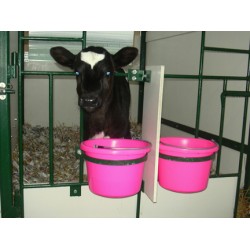ASSESSING disease risk and designing a farm specific herd health programme is essential to protect all beef herds against the effects of IBR.
Establishing herd Infectious Bovine Rhinotracheitis (IBR) status and farm-specific risk factors should be a priority for any beef farm looking to protect health and performance in all ages of stock.
The highly contagious nature of IBR, along with widespread and varying signs of the disease means exposure at any level can have severe implication to both adult and young cattle.
Caused by bovine herpesvirus, BHV-1 the true signs of IBR include respiratory problems in the upper respiratory tract. This can show as pneumonia or conjunctivitis in both adult cattle and calves, with the virus often adding to the weight of calf pneumonia problems.
BHV-1 can also cause milk drop, embryonic losses and general fertility problems. In general, all these signs are collated together and talked about under the umbrella of IBR.
BHV-1 can be spread via the cow’s airways and bull semen. Once infected an animal will become a latent carrier and spread the virus in times of stress, explains vet Andrew Biggs, of the Vale Vet Group.
“IBR is very persistent and has the potential to flare up at a later date in carrier cows. Shedding could be brought on by any stressful event such as calving or bad weather. However once brought on, the flame can start burning through the whole herd.” This could cause resurgence in problems in a herd or could introduce the problem to a naive herd.
Yorkshire vet Jonathan Statham, of Bishopton Vet Group, says IBR can cause particular problems at autumn housing when calves are weaned.
Weaning
“The stress of weaning can add to disease spread risk. You have also got the added risk of warm conditions at housing with animals in close proximity. It only takes one infectious animal to spread IBR to that whole group,” he says.
Producers can commonly see severe pneumonia outbreaks leading to high treatment costs and mortality. Signs include clear, runny noses leading to thick snot within a week. However the underlying sub-clinical effects can be even more dramatic.
“Infection can reduce feed conversion efficiency and effect calf growth rates. You can still have grumbling infection which causes damage to the respiratory tract without clinical signs.”
Infected breeding animals can also experience fertility issues such as abortion and embryonic losses. That could reduce the calf crop for that year, or mean a cow takes longer to get in-calf, leading to reduced calf weights and a greater chance she will be culled.
Mr Statham says it is important to establish the disease status of a breeding herd and design a bespoke herd health plan with a vet. Whether vaccination is appropriate in youngstock and/or cows should be decided after establishing herd risk factors. The decision may be made to vaccinate calves at weaning depending on individual farm situation.
“To check your status, carry out a youngstock check on a sample of animals over eight months old. If bloods test positive it suggests IBR is currently circulating,” he says.
“When the test is negative, it makes boundary repair and biosecurity even more important to ensure you do not introduce IBR. If you do introduce one IBR positive animal to a naive herd it can result in a massive disease outbreak.”
In a naive herd, remaining closed is preferential. However, on all systems, if you have to buy-in, ensure it is from a herd of known disease status.
Bulls
Exposure to the disease could lead to reduced bull fertility, while the fact IBR can be spread via semen also means it is important to include stock bulls in any herd health policy. Knowing the IBR status of the breeding herd is crucial to protect both cows and bulls from infection.
Also check bull catalogues for the IBR status of AI bulls so you do not inadvertently introduce the disease through AI.
When store cattle are being bought-in from multiple sources or from market, the chance of introducing disease is high. As a result, Mr Statham recommends using a live intranasal IBR vaccine on all bought-in stock as soon as they are settled on farm. He says this type of vaccine stimulates a rapid immune response.
“The stress of transport can cause carrier animals to start shedding, so for anyone buying in store or fattening cattle, vaccinating all purchased animals is a good approach to safeguard performance,” he says.
Infectious Bovine Rhinotracheitis (IBR) explained
- Caused by bovine herpesvirus and excreted from airways and bull semen
- Once infected cows become latent carriers for life and can shed the disease when stressed
- Clinical signs include runny noses, pneumonia, loss of appetite, high temperature and milk drop
- Good biosecurity is key to preventing spread. Vaccination can help protect naive animals
- A marker vaccine is available to distinguish vaccinated and naturally infected herds




